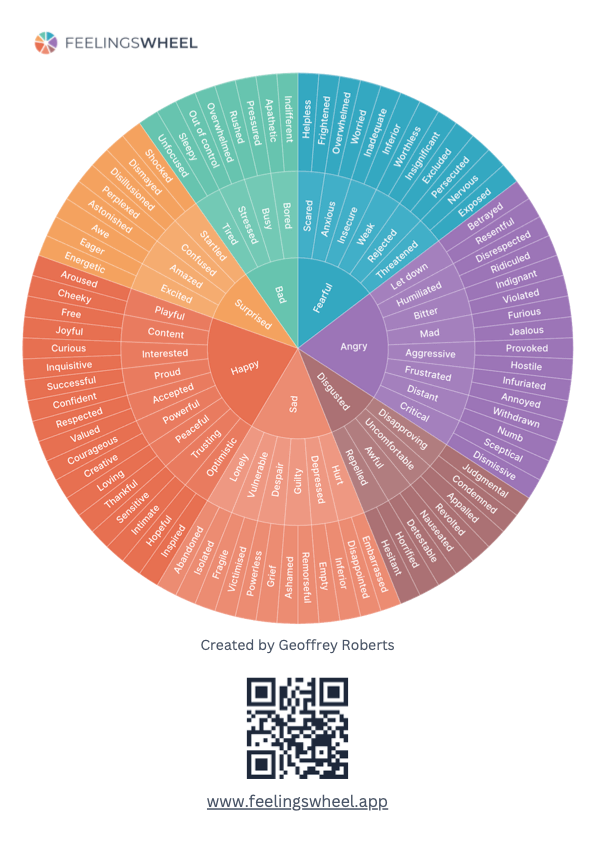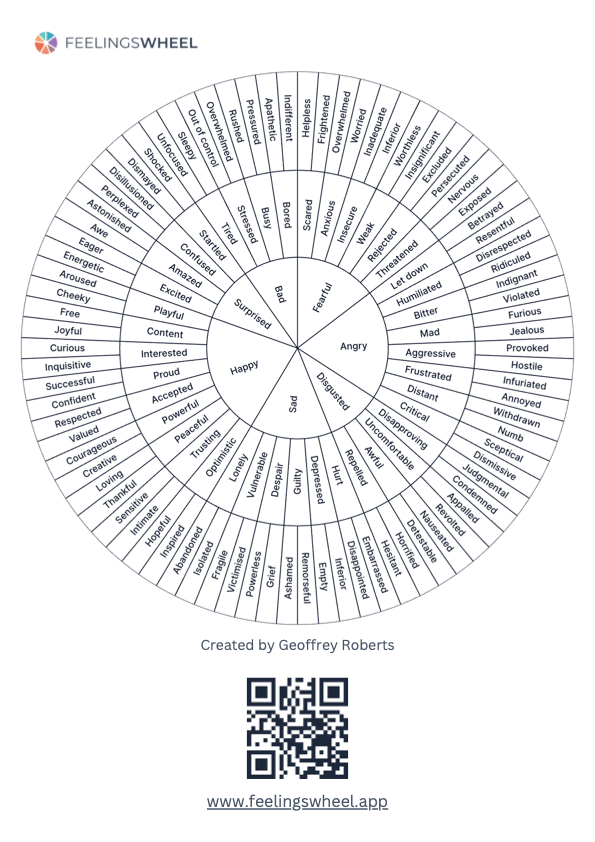How are you feeling today?
Click and turn the interactive
Feelings Wheel to explore your emotions
Take a moment to connect with yourself and find calm by exploring the interactive Feelings Wheel, also known as the Emotion Wheel.
It's a simple yet powerful mental health tool designed to help you identify and understand your emotions better.
Feelings Wheel offers insights that can help you manage stress more effectively by enhancing your emotional awareness.
Selected Feelings (0)
Discover the Spectrum of Positive Emotions
Explore Positive Feelings
Understanding Your Emotions
A Guide to the Feelings Wheel
- The Feelings Wheel Explained
- How Does the Feelings Wheel Work
- Why the Feelings Wheel is Essential
- A Step-by-Step Tutorial
Emotions are powerful forces that shape our lives. But sometimes, pinpointing exactly how we feel can be tricky. The Feelings Wheel is designed to help you navigate the complex world of emotions and gain a deeper understanding of yourself.
The Wheel can be used individually or with others. You canprint it outor use it online. With regular practice, it can become a powerful asset in your emotional intelligence toolbox.
The Feelings Wheel Explained
The Feelings Wheel is a powerful visual tool shaped like a wheel, typically divided into several sections to help you better identify and understand your emotions. It categorizes emotions into different levels, starting with core emotions at the center and branching out to more nuanced feelings on the periphery. This progression helps explore the full spectrum of emotions, going beyond basic feelings to uncover more nuanced states.
How Does the Feelings Wheel Work
The Feelings Wheel typically works in three layers:
- Center: This core layer contains the basic emotions: happiness, sadness, anger, fear, surprise, disgust and bad. These are considered fundamental building blocks of our emotional experience.
- Middle Layer: Expanding on the core emotions, this section offers more specific terms that branch out from each core emotion. For example, sadness might be further defined as loneliness, vulnerability, or despair.
- Outer Layer: The outermost layer contains even more nuanced emotions, offering a rich vocabulary to describe subtle variations in how you feel. For instance, anger could be further categorized as resentment, fury, or indignation.
The Wheel also highlights how emotions can be related. Colors are often used to group similar emotions, and neighboring sections on the Wheel indicate emotions that can blend together.
Why the Feelings Wheel is Essential
Using the Feelings Wheel offers several benefits:
- Improved Emotional Awareness: Identifying your emotions with greater precision is the first step towards managing them effectively.
- Better Communication: By having a wider vocabulary of emotions, you can communicate your feelings more clearly to others, fostering stronger relationships.
- Emotional Regulation: Understanding your emotions allows you to manage them in healthy ways. The Feelings Wheel can help you identify triggers and develop coping mechanisms.
- Increased Self-Compassion: Recognizing the full spectrum of your emotions, both positive and negative, can lead to greater self-acceptance.
A Step-by-Step Tutorial
You never want to make your emotions wrong.
The idea that anything you feel is "wrong" is a great way to destroy honest communication with yourself as well as with others.
Be thankful that there’s a part of your brain that is sending you a signal of support, a call to action to make a change in either your perception of some aspect of your life or in your actions.
- What would I have to believe in order to feel the way I’ve been feeling?
- What am I willing to do to create a solution and handle this right now?
- What do I really want to feel?
- What can I learn from this?
You want to feel certain that you can handle this emotion easily in the future by having a great plan to do so.
One way to do this is to simply remember the ways you’ve handled it in the past and rehearse handling situations where this emotion would come up in the future.
See, hear, and feel yourself handling the situation easily.
- Tony Robbins
Feeling overwhelmed?
some Box Breathing?
Special Thanks
Heartfelt gratitude to the amazing individuals who helped make this project more accessible:


